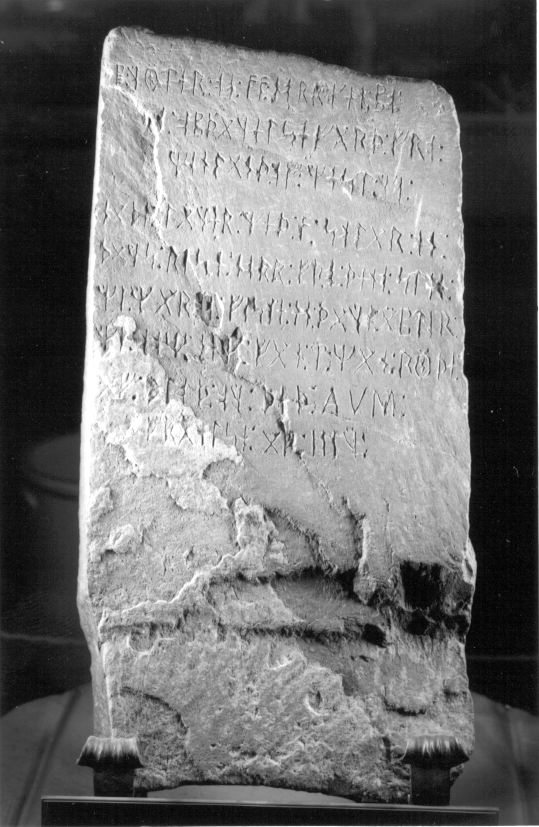April 19, 2004
New Evidence Against the Kensington Runestone
 According to
news
reports,
new evidence has emerged supporting the view that the Kensington Rune Stone is a forgery.
The stone, now housed in the Runestone Museum
in Alexandria, Minnesota, was allegedly found in 1898 by Swedish-American farmer
Olof Ohman on his farm in nearby ᚴᛂᚾᛊᛁᚶᛡᚮᚾ (Kensington).
The inscription (the last part of which is on the side, out of view in the photo)
reads:
According to
news
reports,
new evidence has emerged supporting the view that the Kensington Rune Stone is a forgery.
The stone, now housed in the Runestone Museum
in Alexandria, Minnesota, was allegedly found in 1898 by Swedish-American farmer
Olof Ohman on his farm in nearby ᚴᛂᚾᛊᛁᚶᛡᚮᚾ (Kensington).
The inscription (the last part of which is on the side, out of view in the photo)
reads:
Eight Goths and 22 Norwegians on a journey of exploration from Vinland very far west. We had camp by two rocky islands one day's journey north from this stone. We were out fishing one day. After we came home we found ten men red with blood and dead. AVM save from evil. Have ten men by the sea to look after our ships fourteen days' journey from this island. Year 1362.
Believers in the inscription's authenticity consider it proof that the Vikings discovered America. Most scholars consider it a forgery, most likely made by Ohman himself, but the question is still actively debated. One scholarly proponent of the authenticity of the inscription was the late Robert A. Hall, Jr. who published a book entitled The Kensington Rune-Stone: Authentic & Important. Hall was an early critic of prescriptive grammar, which he attacked in a book entitled Leave Your Language Alone, previously mentioned here on Language Log.
There is a good short summary of the debate in this essay by Richard Nielsen, a believer, and Henrik Williams, a skeptic, on the web site of the Historical Museum in Stockholm. The Museum has available a special issue [PDF document] of its Historiska Nyheter devoted to the runestone. It is mostly in Swedish but has portions in English. Even if you can't read Swedish, it has some nice illustrations with bilingual captions.
The new evidence is the discovery of documents written in 1885 by a Swedish tailor in runes, which had long since passed out of use as the usual means of writing Swedish. These documents provide examples of a secret variety of the runic alphabet used by tradesmen in the 19th century. Some of the unusual runes on the Kensington Rune Stone turn out to belong to the secret tradesmen's version of the alphabet. Since Scandinavian scholars believe that this version of the runes did not exist in the 14th century, the use of these runes favors a 19th rather than 14th century origin.
In a way, it is odd that so much importance should be attached to this stone. On the one hand, there is no longer any question that the Vikings reached North America. We know that they settled at L'Anse aux Meadows. On the other hand, although the Vikings beat Columbus to the New World, they weren't the first. The Indians beat the Vikings by thousands of years.
Posted by Bill Poser at April 19, 2004 11:02 PM